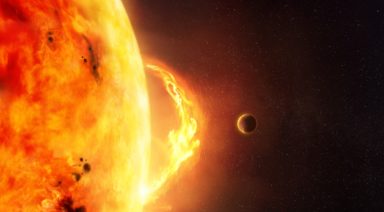The Interstellar Cloud is Bringing Space Weather to Our Solar System

Could a thin layer of gas that is as hot as the surface of the sun affect Earth’s climate?
Our solar system, as it moves through space, is traveling through a cloud and potentially experiencing some turbulence. The Local Interstellar Cloud, or the Local Fluff as it is more colloquially referred to, is a thin layer of magnetically charged gas that is 30 lightyears across and as hot as the surface of the sun. So why hasn’t this scorching, nebulous layer of helium and hydrogen caused problems for us yet?
Luckily, our sun, in addition to providing us with the perfect amount of light and heat, has shielded us with a magnetic bubble that is pushed outward by the solar wind. This protective layer is known as the heliosphere and it is like a carapace for our solar system, keeping cosmic radiation and pesky interstellar fluff from fogging over our planets. But what if that protective bubble were breached, allowing for cosmic radiation to enter our solar system? We know that we experience some cosmic radiation on Earth that originates outside of our solar system, causing ozone depletion, unstable isotopes in our atmosphere, and radiation exposure at high altitudes. But we don’t know what the effects that cosmic radiation originating from the Local Fluff might have on us.
Compression of the Heliosphere
While the heliosphere and heliosheath, an area before the boundary to interstellar space, seem to be doing their jobs, there is a possibility that the Fluff is compressing our bubble. As our solar system passes through the Fluff, it becomes oblong, while simultaneously resisting the magnetic bubble of the Fluff. There is also the possibility that there are ‘cloudlets’ of significantly higher density gas within the Fluff. Could these higher density cloudlets make it through the heliosphere and into our solar system?
The average density of the Local Fluff is about 0.3 atoms per cubic centimeter. To put this into perspective, the density of the edge of Earth’s atmosphere is 12 billion atoms per cubic centimeter. At this extremely thin density, there isn’t much reason to worry about it penetrating our heliosphere, but if cloudlets of significantly higher densities came through, they could potentially burst our bubble. According to astrophysicists, these cloudlets could allow more cosmic rays to penetrate our solar system, potentially wreaking havoc on our climate. But we only have another 10,000 years before we pass through the Fluff and our cosmic sky clears.

Source: NASA
Interplanetary Climate Change
While anthropogenic causes of climate change are undeniable, there could potentially be additional outside factors at play, according to a Russian scientist named Dr. Alexey Dmitriev. This energy that is being emitted from the Fluff could be affecting all the planets in our solar system. Dmitriev believes that this energy is producing hybrid processes and excited energy states in not just the planets but also in the Sun. So, what are the consequences of this for life on Earth?
Dmitriev states that this excited state could accelerate a magnetic pole shift, it could affect ozone distribution in the atmosphere, and it could generally increase the frequency of catastrophic climate events. While this may sound apocalyptic, he says that this is a regular process and it is natural for Earth’s biosphere to undergo these changes. Essentially, Dmitriev says that these changes will create a necessity for adaptation of all life on Earth.
Whether Dmitriev’s prediction is prescient or overdramatic, we may soon have more data surrounding this phenomenon. NASA’s Voyager probes have almost breached the heliosphere to enter interstellar space, where the Fluff begins. The probes are currently in the heliosheath and able to measure the magnetic field of the Fluff. As they get closer they will hopefully be able to tell us more.
Are Humans Being Recruited for Breakaway Civilizations?

Did you ever wake up in the morning and feel like something was off-kilter? Perhaps you were worried about finances or visiting in-laws. However, if you were a breakaway civilization recruit your waking moments might be more like this:
You feel like you were asleep forever, but the clock says it is just a few hours later than when you went to bed. Maybe you just had an incredibly long and detailed dream. After several flashbacks or moments of déjà vu, you recall that you were a member of a Secret Space Program (SSP) and spent years living on Mars as part of a human colony. You remember stopping by the moon for a short time when going to or coming from Mars.
People are recruited for these colonies, known as breakaway civilizations when their particular skills are needed in a new civilization. Explore how breakaway civilizations may be essential for the future of humanity and potential recruitment criteria for colonists.
Breakaway Civilizations; An Off-Planet Solution?
In the early 1940s, President Franklin D. Roosevelt became concerned that a catastrophic event would require the movement of large masses of people away from areas of destruction. The problem became more dangerous when FDR discovered there was no one place on the planet that could accommodate such large groups. He even explored the idea of digging tunnels and underground shelters. These plans seemed unworkable, so he explored the idea of developing off-planet solutions, like establishing colonies on the Moon, Mars, or Venus.
Hackers Uncover Evidence of Breakaway Civilizations
There is strong evidence that breakaway civilizations have existed on the moon and Mars for many years. Two independent computer hackers accessed government computers and found reports indicating there were colonies on the moon and Mars. One hacker, Matthew Bevan, accessed the files in the early 1990s. The other one, Gary McKinnon, accessed records in the early 2000s.
Breakaway Civilizations: Recruitment
There are three recruitment categories for Breakaway Civilizations:
- Some recruits are made
- Some recruits are asked
- Some recruits are taken
1. SOME ARE MADE
Randy Cramer believes he was designated to be part of the SSP and go to Mars prior to his birth. He had no choice and was predestined to be a Breakaway Civilization participant.
2. SOME ARE ASKED
Laura Magdalene Eisenhower, great-granddaughter of President Eisenhower, has shared her experiences of being actively recruited to go to Mars. Eisenhower felt she had been targeted before she was born, but it wasn’t until she was a single mother with twin boys that she was asked. She turned down the “opportunity,” but she has provided details of the attempt that was made to get her to join the project.
3. SOME ARE TAKEN
David Paulides heads a group of retired police officers and others who are experienced Search and Rescue experts (SAR). Their mission is to investigate the thousands of reports every year of missing persons. Paulides documents the mysterious disappearances of people around the world. He says these people are “brilliant scholars, athletes and stellar people.” They suddenly disappear under questionable circumstances.
Development of Technology Supports The Existence of Breakaway Civilizations
There is evidence that technology for space travel now allows people to travel from Earth to the moon or Mars without traversing the distance between the places. This technology involves teleportation or some type of secret portal. When you consider all the advancements that have been made in technology that we use in our daily lives, it makes sense that similar advances would be made in the technology used for space travel.
We have gone from fax machines to scanners and email. From landlines to cell phones. We have gone from the original computer that was the size of a large closet to handheld devices with many more available functions. So, isn’t it possible that space travel technology would also experience such advancements, including how to travel in space by teleportation through portals or some other equally fast way?
Mind Control Devices: Project MK-Ultra
The CIA is known for several mind control programs. Project MKUltra, a secret CIA project designed to test the effect of drugs on humans, was conducted on unwitting subjects from 1953 to 1964. During the program, experimenters gave test subjects drugs that caused them to have hallucinations and other adverse reactions. Other drugs erased memories of time and events.
In 1976, the U.S. Senate investigated the MKUltra program. Senators were shocked by some of their discoveries. For example, Congress learned that the secret program was designed to discover drugs that could help people “withstand privation, torture and coercion during interrogation and so-called brain-washing” and other drugs “which will produce amnesia for events preceding and during their use.”
Using these drugs, along with technology learned from aliens, explains why Randy Cramer and the other whistleblowers would at first have no recollection of their trip. Other drugs to reverse memory loss along with therapy allowed them to recover their memories. Some people view the concept of breakaway civilizations as a “pipe dream” shared by a few folks who are trying to bask in their 15 minutes of fame by telling their incredible stories of life on Mars. What do you think? Share your comments below.
Want more like this article?
Don’t miss Deep Space on Gaia for more on the long and hidden history of Earth’s secret space program.




































